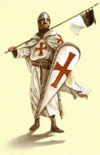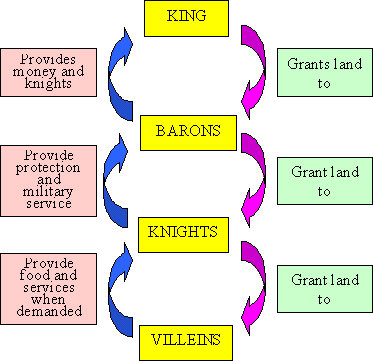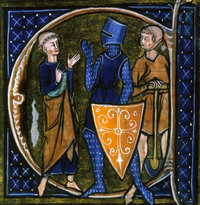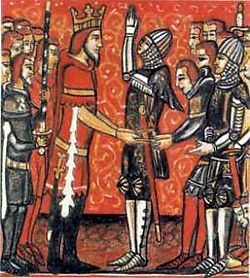Our story
This Chapter
|
|
"By the Lord before whom this sanctuary is holy, I will to N. be true
and faithful, and love allwhich he loves and shun all which he shuns, according to the laws of God and the order of the world. Nor will I ever with will or action, through word or deed, do anything which is unpleasing to him, on condition that he will hold to me as I shall deserve it, and that he will perform everythingas it was in our agreement when I submitted myself to him and chose his will." 0A January 7, 2015 Now why would people like Reynart and Jan de Jonge have gotten themselves almost killed by fighting in some savage conflict between the Dukes of Brabant and Jülich? The answer is found in the feudal system (Dutch: leenstelsel; German: Lehnswesen) then in existence. 3 Feudalism is a stage in the evolution of society's political and social organization. The most common model of this is that of medieval Europe. The illustration shows the basic principle although we shall find the title Duke more common than Baron. In simplest terms, feudalism was meant to ensure sustenance and protection up and down the social ladder. 4 Lords and their vassals played the key roles. A lord was one with rights to a piece of land and granted the use of a part of this land to a vassal. That land, a fief or feu,* included the labor of the serfs living on it. In return for gaining the fruits of land and the serfs' labor, the vassal owed his lord military service, including horses, horsemen, footmen, arms, etc. as needed and contracted for by an oath of fealty. Vassals, in turn, may act in the same manner; a process called infeudation. This lord-vassal relationship was not restricted to members of the laity; bishops, too, could be vassals and lords. Although a vassal gained revenue from his fief, it remained a loan and so it was his lord's responsibility to protect land and vassal from harm. 6 The primary reason then for a lord to enter into a feudal relationship was to secure military help when needed or desired. But the vassal might have other obligations as well. One was to provide his lord with counsel. A lord facing a major decision, such as whether or not to go to war, would summon his vassals and hold a council. Additionally, a vassal may have been required to yield a certain amount of his farm's output to his lord. A vassal was sometimes required to use--for payment--the Lord's mills and ovens to grind his own wheat and bake his own bread. 7 Thus we perceive there was an obligation for the vassal of Amstenrode to come to the aid of the Duke of Brabant. And the Duke, presumably, owed his vassals the payment of ransom to secure their release from capture. Without further information available, one might presume that Reynart fulfilled a military obligation that rested on his father, Vaes Huyn van Amstenrode. 8 A fief could take forms other than land; it could be anything that produces wealth, such as an important post with its privileges and income, or the right to collect tolls or operate a mill. An office holder, in return, owed advice or participation in judicial procedures or other important services. He may even have been obliged to give financial assistance his lord's oldest son engages in a marriage. In short, the feudal system involved business as well as personal affairs. 9 At the bottom of the feudal heap were the serfs (from the Latin servus, meaning slave, servant). Or, really, one may well imagine, their spouses were. The serf, too, had a feudal contract: in return for protection, he would reside upon and work a parcel of land held by his lord. In those days, the overall rational was a simple one: a serf worked for all, a knight or baron fought for all, and a cleric prayed for all. 10 Aside from a small number of Jews, everyone in Europe, from kings down to the lowest serf, was a Christian. The parish church was the center of every town and was involved in every aspect of evryday life. A newborn infant was baptized here and thereby entering into union with God. A child was taught basic prayers and indoctrinated in his responsibilities to the Church. A couple would exchange their wedding vows before God in this church. If crops failed or someone fell ill, people would come to church to pray to God for help. When a person died, the final prayers would be said there and the body would be buried in ground that had been consecrated by the Church. People were expected to attend church services regularly, live by the Church's laws, and pay heavy taxes to support the Church. In return, they were shown the way to a happy, everlasting life after lives lived in the here and now, lives that were often short and hard. 12 In addition to collecting taxes, the Church also accepted gifts of all kinds from individuals who wanted special favors or wanted to be certain of a place in heaven. These gifts included land, flocks, crops, and even serfs. Thus the Church amassed great power which it often used to influence the rulers. If someone went against the Church, the Pope could excommunicate him. That person could no longer attend church services or receive the sacraments and upon death would go straight to hell. At a time when everyone thoroughly believed in heaven and hell, this was an awful punishment. 13 Church services were in Latin, which people didn't understand. On Holy Days, when the Church forbade them to work, the people came to give praise to God for the good things in their lives. The parish church was overseen by a parish priest, whose duties were to teach the Christian gospel to his parishioners, and help them to live their lives by God's laws. 14 Because of religion's importance, many wished to devote their whole lives to being closer to God and doing the Church's work by becoming monks or nuns. Sometimes, parents promised their children to this religious life in order to fulfill a promise to God and to ensure their children were never homeless or without food. 15 The Church greatly influenced the shaping of feudalism because eclasiastical hierarchy somewhat paralleled feudal hierarchy. The church owned much land, held by monasteries, by church dignitaries, and by the churches themselves. Most of this land, given by nobles as a bequest or gift, carried feudal obligations; thus clerical land, like lay land, assumed a feudal aspect, and the clergy became participants in the temporal feudal system. Many bishops and abbots were much like lay seigneurs. 16 Medieval villages, or manors, consisted of a manor house, where the landlord lived, and the peasants' one-bedroom huts made with wooden beams, mud and straw. The essential characteristic of a manorial society was the near-total subordination of the peasants to the economic authority and jurisdiction of the landlord. Most serfs were farmers, but some were craftsmen, such as blacksmiths or millers. 17 Towns were at first part of a lord's or king's domain, providing him with considerable wealth. But as townsmen becaming wealthier they began to rebel. In northern France towns struggled, with violent scenes in the streets, to become independent "communes." In England, things evolved more peacefully. Eventually, towns were obliged to pay a fixed sum each year in return for their burgesses' right to govern themselves. Towns made heir own laws and raised their own taxes. 18 As said, the feudal system was a stage in the evolution of how society hangs together. And just as modern society has roots within feudalism, feudal society had its roots in what went on before it evolved. In the main these go back to Roman times, but in part also to Germanic tribal customs. Following a process of altering existing institutions, feudalism first appears in definite form in the Frankish lands in the 9th and 10th centuries, developed and exploited by the Carolingians (Pippin, Charles Martel, Pippin the Short, Charlemagne). 19 During the Early Middle Ages, the stem duchies (from the German Stammesherzogtum) formed the major divisions of the eastern Carolingian kingdom of (East) Francia (a region roughly corresponding to modern Germany, but larger). Most of these duchies corresponded to major self-identifying cultural groups, whether tribes or confederations, which German historians later called stems in the sense of the trunk of a genealogical tree (Stammbaum; the German word Stamm means trunk as well as tribe). Each nation or tribal confederacy accepted as leader a warrior chieftain acclaimed from the worthiest men of fighting age in a ruling family. The military leaders had acquired the Roman title of dux (leader) under Carolingian rule, part of the conscious revival of Romanized customs and formulas that characterize Charlemagne's court. The stem dukes loosely controlled a group of great nobles, and were expected to appoint bishops and abbots. Some clerics became very rich, even politically significant as prince-bishops within their territories. 21 The concentration of power in the hands of a few was always a great disruptive force in the feudal system. The rise of powerful monarchs in France, Spain, and England broke down the local organization. Another disruptive force was the increase of communication, which broke down the isolated manor, assisted the rise of towns, and facilitated the emergence of the burgess class. This process was greatly accelerated in the 14th century and did much to destroy the feudal classifications of society. 22 The breakdown was gradual. It was not completely destroyed in France until the French Revolution (1789). It lasted in The Netherlands--essentially under French rule from 1795 to 1813--until 1798. In Germany it persisted until 1848, and in Russia until 1917. Many relics of feudalism still persist in today's society: we still have our pecking orders. 23 Our main concern with feudalism is how it impacted on the lives of the early Merckelbachs. We now realize that they had obligations toward their liege lord, the Duke of Brabant. We also realize that preparing for a battle such as fought near the town of Baesweiler required extensive training. We do not know (yet) precisely how the first Merckelbach, Reynart, was raised and how he lived, but in lieu thereof general descriptions of medieval life exist, but there might be some major differences between the way things were in continental Europe and in England. The following notes draw on an English model! (Ref.). 24 Training began at age seven. A nobleman or knight would have his son serve as a page in a lord's castle. There, he would be taught horsemanship, archery, and swordsmanship, and perform various duties around the castle. Next step up is becoming a squire with training beginning roughly at age 10. Most trainees would be attached to a knight for further training at age 14. The training concentrated on strength, fitness and skill with various weapons. Individual training was only part of the regimen, because knights also needed to know how to fight as part of a team of skilled horsemen. The squire would take care of the knight's horse, clean the stables, polish the knight's armor and maintain his weapons. He would learn the chivalric codes of conduct and listen to epic tales of Roland, Charlemagne, Arthur, Percival and Lancelot. Around age 21, the squire would go through the dubbing ceremony. In the early Middle Ages, this was simply done with a brief, open-handed blow to the neck followed by an admonition to conduct himself with courage, bravery, skill and loyalty. 25 After the 11th century, the Church expanded this ceremony to incorporate seeds of religious chivalry--needed to fight the Crusades--and, in return for their loyalty, a guaranteed place in heaven. The dubbing ceremony became much more elaborate during the 11th and 12th centuries. Some would pray alone in church the night before the ceremony, wearing simple clothes to prove humility before God. The priest would bless his sword, and when presented to him, the new knight would kiss the hilt, which often contained religious relics. 26 
A Templar Knight. Quoting Bernard de Clairvaux, ca. 1135, in De Laude Novae Militae: "[He] is truly a fearless knight, and secure on every side, for his soul is protected by the armor of faith, just as his body is protected by the armor of steel. He is thus doubly-armed, and need fear neither demons nor men." (Source.) 27 To keep their skills honed, medieval knights often challenged rival knights to tournaments. The first tournaments were mock battles. Jousting, where two knights would face each other atop horses, and armed with lances and shields, may have begun as a way to settle disputes within the ranks. A knight won when he hit an opponent's shield or helmet. Jousting reached its height as a medieval spectator sport in the 13th century, where thousands would crowd the stands. Sword fights with blunt blades were also part of the tournament. Most medieval weapons could have been used at some point in the competition, from battle-axes and maces to daggers and fists. 28 Medieval education was often conducted under the auspices of the Church. During the 800s, Charlemagne realized his empire needed educated people if it was to survive, and he turned to the Catholic Church as the source of such education. He decreed that every cathedral and monastery provide free education to every boy who had the intelligence and the perseverance to follow a demanding course of study. Grammar, rhetoric, logic, Latin, astronomy, philosophy and mathematics formed the core of most curricula. Classical texts served for science education and a medieval student might learn that hyenas can change their sex at will and that an elephant's only fear is of dragons. Fact is, students learned more about nature's wonders when venturing into the countryside and talking with trappers, hunters, furriers and poachers. 29 Students often sat together on the floor, scrawling notes from lessons using a bone or ivory stylus on wooden tablets coated with green or black wax. Knights were also educated and looked down upon if they could not read and write. Girls were virtually ignored when it came to education. Only daughters of the very rich and powerful were allowed to attend select courses. At 14 or 15, some scholars would continue education at a university. 30 The objective of this chapter is to provide a background for aspects of our story. However, at the time of writing, I am not quite clear as to precisely what to include and, hence, I expect to update this chapter from time to time--as indeed I do with all other chapters of Our Story. It appears that at the time of the first Merckelbachs, feudalism was breaking down at the top of the pyramid because of the weakness of monarchs. Social systems are no more rigid than history as a whole. The Decree Abolishing the Feudal System referenced below makes for interesting reading. It is a degree that had a strong impact on, what is now named, the Dutch Patriciate. 31 Bibliography
|
|
The word feudalism ultimately derives from a Germanic word for cow and became gradually applied to denote valuable, movable property. It is not a medieval term but an invention of 16th-century French and English lawyers to describe certain traditional obligations between members of the warrior aristocracy. Not until 1748 did it become a popular and widely used word, thanks to Montesquieu's De L'Esprit des Lois. In the 18th century, Enlightenment scribes used the word to denigrate the Ancien Régime, or French monarchy. Enlightenment authors generally mocked and ridiculed anything from the "Dark Ages." including Feudalism, thereby projecting feudalism's negative characteristics on the French monarchy. * fn1 |
--
| top of page |
|
Page maintenance:
Page format:monh xx, 2015
Story edit:
To be checked for timeliness:
¶ none
Reminders:
¶ none
Linkcheck: not done
XHTML verify: April 8, 2015
Backups: month. 25, 2011
This chapter is likely to be revised and the bibliography is still to be done.



